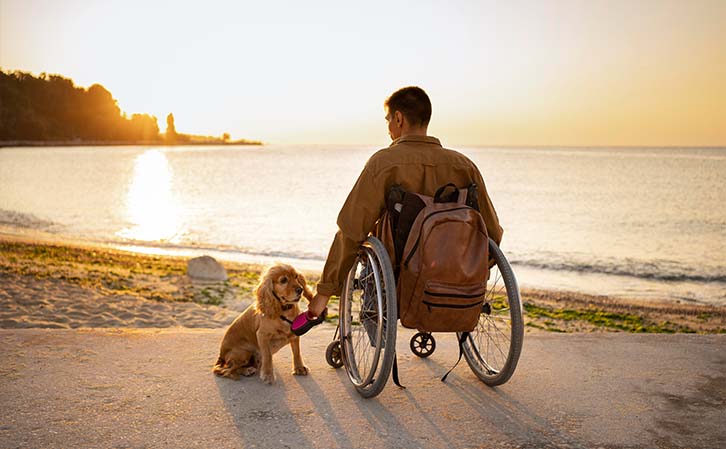How to Walk a Dog From a Wheelchair

Wheelchair-users are extremely fond of dogs, from therapy animals to service animals, and many prefer to walk their dogs themselves. The great thing about taking a dog for a walk in a wheelchair is that there is a multitude of options depending on your ability. Your dog’s size and temperament, as well as the type of wheelchair you use, power or manual, should be taken into account when deciding. Read on for some of the most popular ways to walk your dog from a wheelchair.
Using a Regular Leash?
Many wheelchair-users like to keep things simple and use a "normal" leash, and it can work swimmingly well. You must however be REALLY careful if you have limited dexterity. If it slips out of your hand, your dog could easily get away. Or if you wrap it around your wrist thinking it’s secure, the dog could pull too hard and hurt your wrist.
For extra safety, some will tie the leash to their wheelchair in a variety of places depending on their ability level. Some in power wheelchairs will tie the leash to the back of their wheelchair (on a push handle or on a bar) or to their armrest. Manual wheelchair-users will do the same, or if they have a strong enough upper body, they’ll tie it to their footplate. And for the ultimate in security, tie the leash around your thighs. If you have heavy thighs and the leash is tied well, this can be an excellent anchor.
Arm Attachments for Any Ability
One of the most universally accessible leashes ideal for walking your dog in a wheelchair is using a metal arm attachment attached to the side of your wheelchair. It's a great way to walk a dog completely hands-free. If you have little to no arm movement this is a great option. And there are several different arm attachments to choose from. To decide, make sure to get an arm attachment that’s long enough for your wheelchair and tall enough to accommodate the height of your dog.
When searching, these arm attachments were originally created for bicycle users walking their dogs, and these are the ones you’ll want to purchase. Also, always put a harness on your dog when using an arm attachment in order to keep your dog’s neck area safe.
Try a Wrist Leash
For quadriplegics, or for anyone who wants to be very safe, a wrist leash ensures you will never accidentally drop your leash, and there are several options available. The Liberty Wristband Leash (https://www.libertywristband.com/) is a popular choice. This leash wraps around the wrist with a Velcro strap and has a quick-release button in case of an emergency.
There are body leashes you can put around your torso or shoulder area, or waist, to anchor the leash. Magic Link is a popular hands-free leash. Check it out: https://fablepets.com/products/magic-link?gclid=CjwKCAjwk_WVBhBZEiwAUHQCmTWDT4jZlKmoUgQFh_X7X1nQM7QDSouSde9HsDjmDPoCtxpPZApnShoCGOAQAvD_BwE. And lastly, a wrist leash is a great option for paraplegics who want to walk their dog and still push their wheelchair at the same time. Hand-cuff leashes have the leash attached to the cuff in order to allow the fingers to be used freely.
Also, don't forget to go slowly with your dog when using a new leash or if your dog is new to walking by a wheelchair. While service dogs are trained to walk perfectly aside from a wheelchair, most dogs will need patience and training in order to avoid being caught up in your wheels. Have fun, and remember, walking a dog is for everyone and for every ability.
Stay Updated on Advancements On Traumatic Brain &
Spinal Cord Injuries
About the Author




